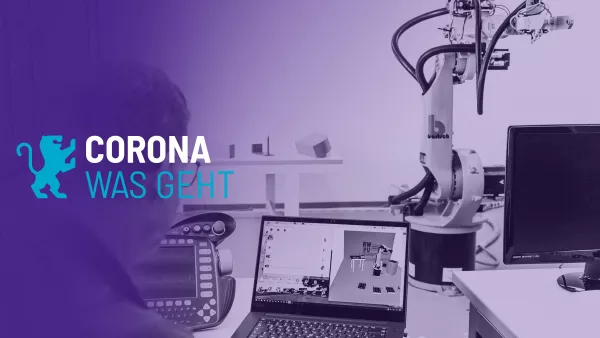
RWU does not stand still even in these extraordinary days and weeks. In many places new solutions are being worked on with commitment and creativity. With the series "Corona - What's up", we want to focus not only on what is currently not possible, but especially on what's up.
The robot is lamenting. Vivien Glönkler translates the text on the computer screen: "It's too hot for him now." The massive metal arm protrudes from the floor and doesn't seem temperature-sensitive. Just as the reference to the danger it can pose to people in its environment does not give any indication of such airs and graces. Glönkler, academic employee in the robotics laboratory, turns on the cooling system and it rushes off. "That's music," laughs Professor Konrad Wöllhaf and sits down in front of the laptop. Now the sensitive machine has to show what it can do. In real and virtual terms.
In RWU's industrial robotics laboratory, students usually test and refine programs that they write for the machines in the lab. Social distancing and hygiene measures make this difficult. Nevertheless, Konrad Wöllhaf wanted to successfully guide the students through their experiments in the laboratory. The aim was to reproduce room and machine in such a way that the results of the programming could be seen purely virtually. To achieve this, the Professor of Robotics and Simulation created the laboratory including the robot as a virtual copy. Students can now program and control this virtual robot on their own PC, no matter where they are. It behaves exactly like its real model. "This makes it more concrete for the students and they can see what they have programmed even though they cannot be in the lab," explains Wöllhaf. The simulation of these processes is also relevant for professional practice: "This corresponds to the way we work in industry. There, entire production halls as well as the robots inside of them are planned and simulated on the computer."
The tasks for the students were somewhat less extensive. For example, they consisted of teaching the robot to write the matriculation number on a given surface. What sounds simple for humans is complex for the robot. "The simplest things get complicated in robotics," says Wöllhaf. It's as if you have to give a human being precise instructions for an action. Now move your hand a little to the left. Arm down. Now bring the fingers together, but not too fast. Without help, without an appropriate input, the robot does not know where it is or what there is around it. For orientation you have to teach him reference points. Once the machine has been programmed and taught, repetitions get all the more efficient.
Long-term goal: human-robot cooperation
The robotic arm moves at breakneck speed and precision. It swivels around, stops abruptly, only for a moment until the next movement is performed. All accompanied by a pneumatic snorting and hissing. In the laboratory, a photoelectric barrier separates robots from humans and protects especially the latter. Industrial robots can be dangerous. They are strong, fast and stupid. This, combined with their undemanding nature, distinguishes them for many jobs. Wöllhaf describes their usual field of work as "dull, dirty, dangerous." That could change in the future. The robots of the future may no longer work in cages, but hand in hand with humans. To do this, they will have to notice in time if an arm or head is in the way and react quickly. Robots and humans should complement each other without endangering each other. "An exciting goal, but it will still take a while before it becomes suitable for everyday use," Wöllhaf is sure. "The safety guarantee - all the risks and legal consequences – that’s not easy to sign."
Meanwhile, the robot in Wöllhaf's laboratory is busy with other things. He picks up tennis balls, places them on a scale and sorts them into appropriate templates according to weight. When all the balls are tidied up, his arm snaps into the starting position with a hissing sound. Nothing moves anymore. His representation on the screen does the same. In the virtual laboratory, the program generates balls and applies a weight to them at random. Not only the robot, but also the space and the properties of the things in it are part of the simulation. The screen shows reliably whether the sorting program was written correctly.
A profit for the time after the pandemic
Konrad Wöllhaf began work on the virtual laboratory in mid-March. It was ready in May. "I was already prepared, otherwise I wouldn't have made it so quickly." 70 students have completed the lab since then. Is a digitalized lab also a more efficient one? Yes, says Wöllhaf, because the usage times do not have to be planned. Everyone has a robot on their laptop. He sees another benefit, even beyond the Corona pandemic: "The use of the digital robot is more playful, more is tried and more is dared. Risks can be taken." After all, neither man nor machine are at stake. But the program cannot replace the work in the laboratory. Konrad Wöllhaf and Vivien Glönkler look forward to normal operation. "This is a challenge for everyone, we are all struggling. This is just one example of what can be done in teaching despite Corona," Wöllhaf says.